Uncategorized
Yamaha Tenere 700 Rally Mods: The Race Build
We’ve already talked about the T7 mods for those of you wanting to take this bike to the next level…But what about riders hoping to enter a rally race or do some seriously gnarly off-road on Yamaha’s newest offering? We’ve got you covered: this summer, we’ve finished our Yamaha Tenere 700 rally mods for a race build.
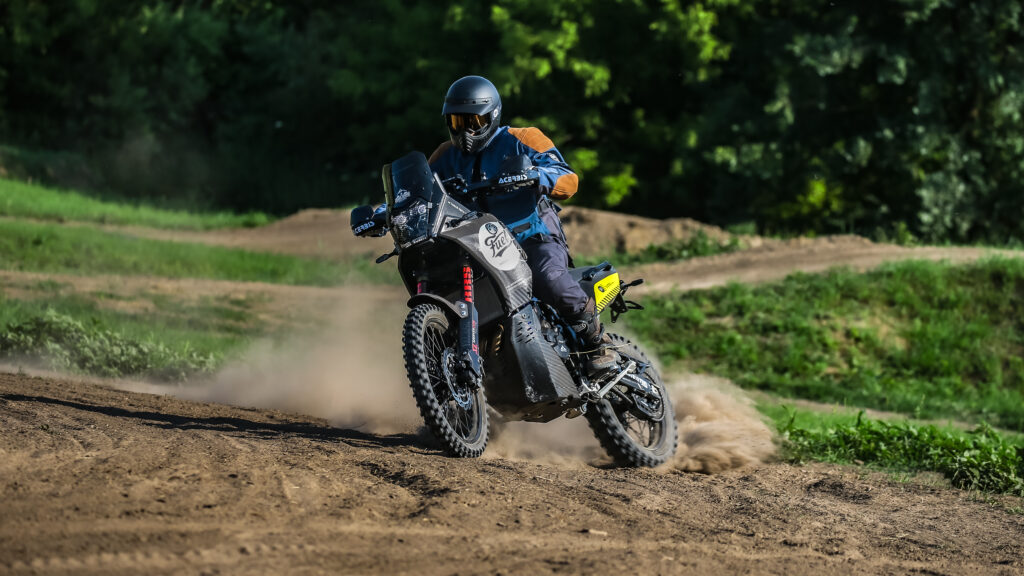
The Tenere 700 is an amazing bike: it’s very simple, especially on the electronics side of things; it doesn’t use a CAN-bus system, has a regular Bowden/cable throttle mechanism, almost doesn’t have any unnecessary sensors or comfort electrics, and it’s easy to modify. The T7 tolerates just about anything – for example, you can remove the dashboard or the ABS unit and the bike still works. Finally, it’s got a torquey engine, and the bike’s gearbox and geometry are a perfect base for building a race-ready rally bike.
We used a Yamaha Ténéré 700 (XTZ 690) 2023 model, EURO-5, standard version as our base. The goal? To build the ultimate bike for rally racing, motocross and enduro training, and hardcore offroad adventures. And yes, the unicorn bike doesn’t exist – but we did have a lot of fun chasing that unicorn with the Yamaha Tenere 700 rally mods.
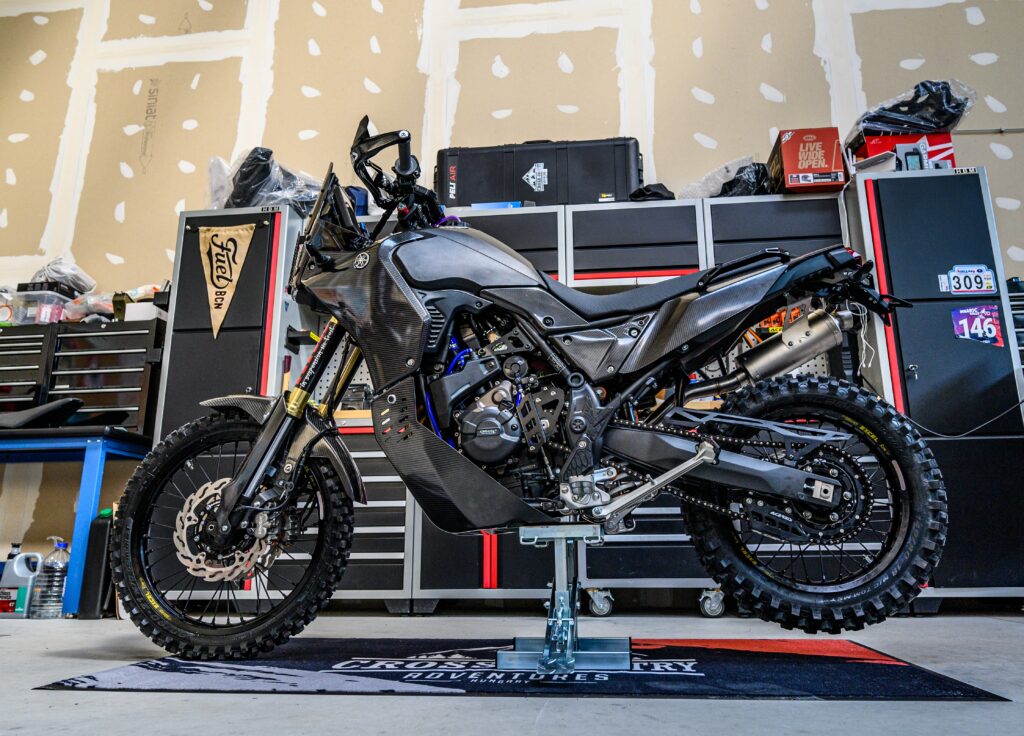
Here’s what we did:
Wheels and Tires
To create a solid wheelbase, we used HAAN wheels (Excel Takasago rims, CNC machined hubs, reinforced spokes) sized 1,85*21″ at the front and 2,5*18″ at the rear. We chose a narrower rear wheel to be able to fit mousses, and it’s usually better for off-road riding. Next up, we installed a cush drive (rubber dampening between the sprocket carrier and the hub) in the rear hub.
Our favorite rubber is the Metzeler MC360 mid-hard tire set. It’s a great intersection point between durability, grip on every surface and terrain, and pricing. For mousse inserts, our preference is MEFO rally mousses – we found them much better and more durable than, say, Michelin.

We use rim locks on both wheels to keep the tires in place and prevent tires slipping off the rim in case the mousse wears out or collapses.
Brakes and ABS
For the braking system, we chose the Moto-Master brake discs (2 in front and 1 in the rear) and brake pads. We changed the brake hoses to Goodridge steel braided brake lines and bypassed the ABS system, putting the brake lines between the brake cylinders and brake calipers. After some consideration, we’ve removed the ABS system completely.
We’ve replaced the rear brake cylinder with a Nissin brake pump featuring an integrated reservoir (the system is simpler, and the bike is cleaner without the unnecessary hose and separate plastic reservoir).
As for the front brake, we feel modifying it to a “one-side” brake isn’t necessary. Sure, it’d save some weight and make the front of the bike simpler, but it’s not a huge advantage. In addition, if you sometimes need to use the front brake a lot – and the T7 is a heavy bike – and your one-side brake overheats, you’re left with nothing in a situation where that could cause a major issue.
Chain And Sprockets
We’ve chosen to go with a D.I.D 525 ZVMX X-Ring chain, which has a length of 124 links. The reason for selecting this specific chain length is twofold. First, it will allow us to install a larger rear sprocket. Second, having that extra length enables the rider to adjust the rear axle position by moving it slightly backward for improved performance.
For the front sprocket, we’ve opted for a JT Sprockets with 15 teeth. This sprocket is made of sturdy steel and features a silent rubber coating, which is great for reducing noise and ensuring smooth operation.
Moving to the rear sprocket, we’ve gone for a ZF Sprockets Dual design. This rear sprocket boasts high-grade aluminum on the inner portion and a highly durable C-45 steel outer teeth ring. It’s designed with 48 teeth and matches the 525 pitch of the chain.

You might be wondering why we haven’t considered switching to a 520-pitch chain and sprockets, which can save a small amount of weight. Well, the reason is simple: we’ve decided to stick with the 525 pitch chain because the slight weight savings of the 520 chain aren’t worth the potential risk of it wearing out much quicker. In the end, we prioritize durability and reliability in our Yamaha Tenere 700 rally mods.
Exhaust System
We’ve installed the HP Corse 2-in-1 Racing head pipe, constructed from stainless steel, and it doesn’t come with a catalytic converter; intended strictly for race use. Accompanying this head pipe is the HP Corse SP-1 Short High exhaust muffler, which boasts a construction of titanium and stainless steel. To enhance its function, it features a carbon heat shield on the linkage pipe. We’ve positioned the muffler in a high and protected location, just behind the OEM exhaust mounting bracket.
One remarkable advantage of this setup is that it won’t cause any damage to the swingarm, nor will it break the OEM bracket in case the bike is dropped. Additionally, it doesn’t pose any issues with heat when we utilize saddlebags, rackless bag systems, and the like.
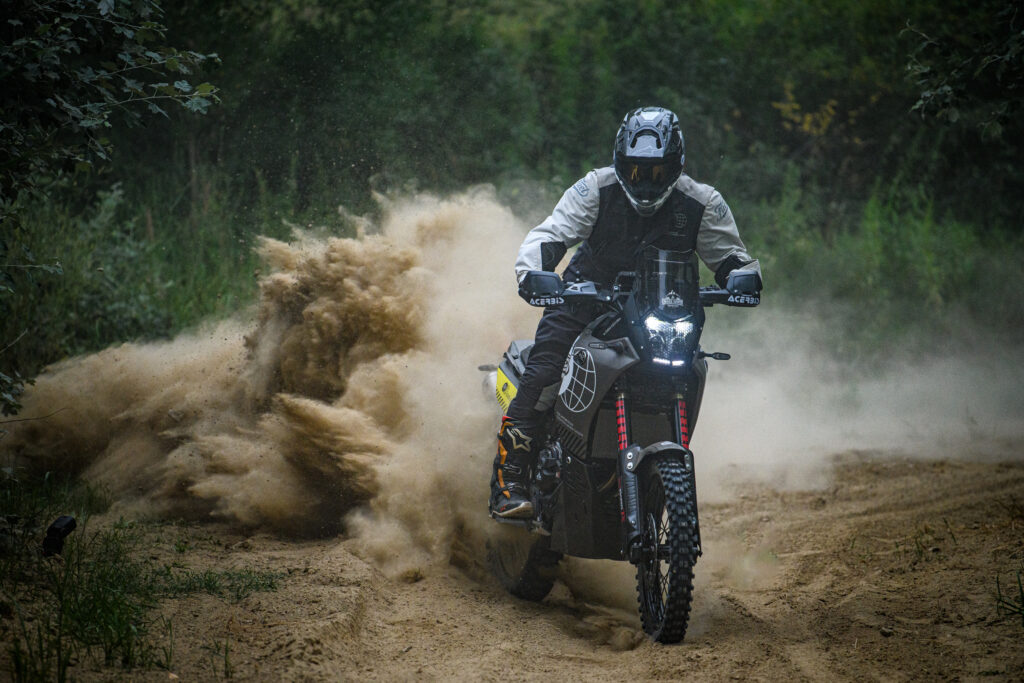
Now, let’s talk about the sound of this system. It’s truly impressive. While it’s not excessively loud, starting the bike will undoubtedly turn heads. The sound it produces is akin to a V8 Mustang, which might come as a surprise considering it originates from a 2-cylinder parallel 700cc engine.
Prior to receiving the HP Corse muffler, we had to rely on an alternative for a couple of months. We chose the MIVV Dakar Exhaust, which closely matches the parameters, size, positioning, and sound of the HP Corse muffler. It’s been a great temporary solution while we awaited the arrival of the HP Corse muffler.
Suspension
We’ve made some significant changes to our suspension setup. First and foremost, we retained the 43mm fork legs but opted to completely empty them and install the TracTive X-TREME PRO high-performance closed cartridge system. This system offers adjustable rebound and compression damping, along with manual preload adjustment. It features a 35mm piston diameter and is designed as a closed cartridge system, primarily developed for professional off-road riders. Additionally, we replaced the rear shock with the TracTive X-TREME PRO, which includes a hydraulic preload adjuster. This ultimate performance shock absorber boasts adjustable rebound and high- and low-speed compression damping, with a 46mm piston diameter and PDSII anti-bottoming feature.
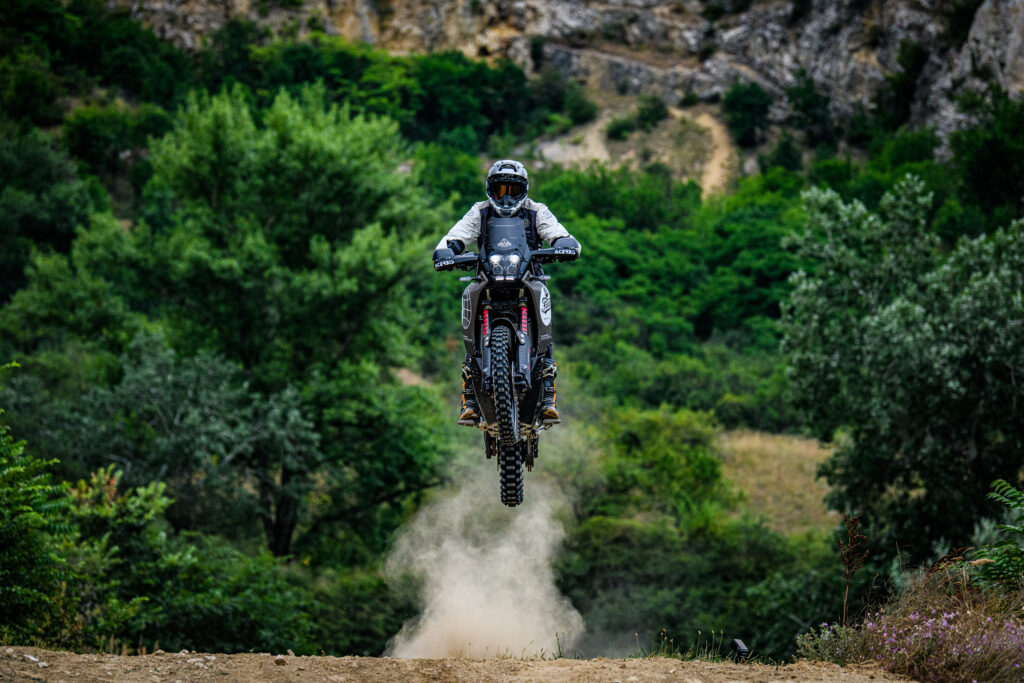
Unfortunately, after some 3,000km of rally racing and intense motocross and enduro training, we blew the Tractive X-treme Pro cartridge in the OEM size (43mm) forks. Because of this, we’re considering upgrading to 48mm forks and a matching triple clamp; however, we’re still checking out options as this might make the T7 much taller. We’d like to avoid this as the bike is already tall with the rally seat, and sometimes, that causes problems with more technical, hard enduro riding. Either way, the forks will need to be reinforced.
What’s important to note is that we didn’t alter the suspension travel length, which remains at 210mm in the front and 200mm in the rear. We firmly believe that this length is more than sufficient if you have the right setup tailored to your riding style, matching springs according to your weight, and professional adjustment to your riding skills.

Our rigorous testing, including jumps on motocross tracks and participating in events like the Bosnia and Dinaric Rally where we encountered substantial obstacles like rocks and holes at high speeds, proved that we never hit the bottom of the suspension. We consistently had around 1.5-2cm of spare travel. In general, we do not recommend increasing the suspension travel length, except in rare cases like riders over 190cm tall who may consider going to 230/225mm travel. However, it’s crucial to remember that such changes should include modifications to the fork tubes, not just the internal components. We also strongly advise against lowering the bike as it adversely affects the bike’s geometry.

If you find yourself thinking about increasing travel length or lowering your bike, it’s an indicator that your setup may not be right, or it’s not properly adjusted. Improving your riding skills might be a better approach to handling the bike effectively.
Fuel Tank and Filter
For our fuel system, we’ve made some noteworthy changes. We’ve replaced the stock fuel tank with an Acerbis oversized fuel tank, boasting a capacity of 23 liters (6.1 gallons). This plastic tank offers several advantages over the OEM option. Notably, it’s slightly lighter, shedding about 2 kilograms compared to the stock tank. Plus, there’s no obligation to fill it to the brim – flexibility we appreciate. It’s also built to withstand impacts and abrasion. Additionally, this tank maintains a narrow profile, ensuring compatibility with the original fuel pump and level switch. It’s also designed to work seamlessly with tubular engine guards, crash bars, and fairings.
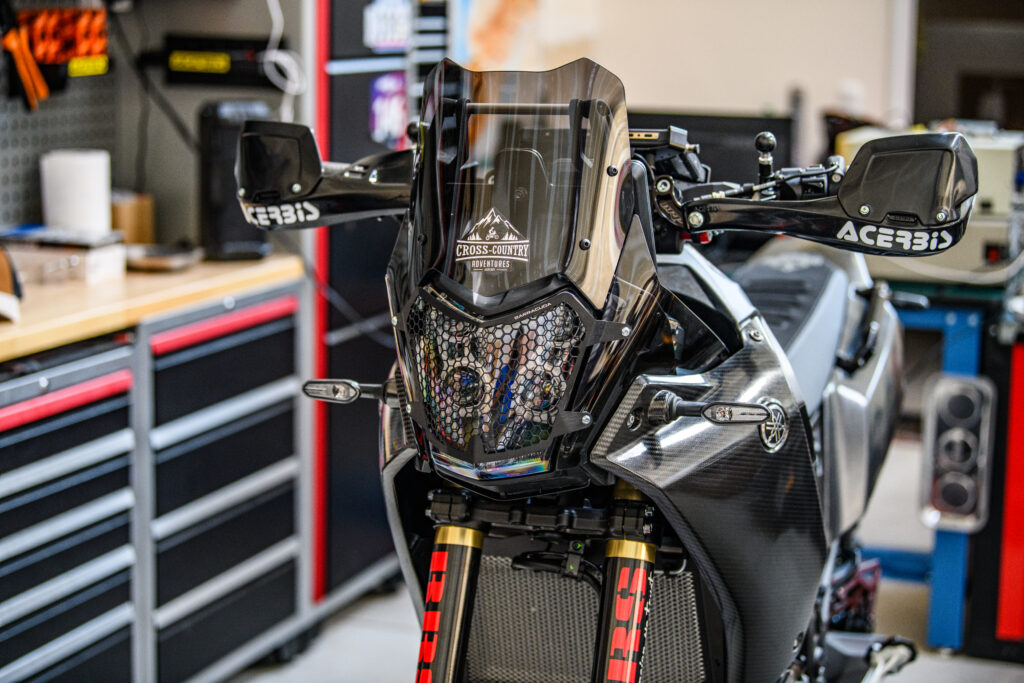
As we relocated the ECU and all the cables to the middle of the bike under the seat and cut down the OEM exhaust mounting bracket, there’s now a clean space on both sides of the rear subframe. We’re designing a rear fuel tank and considering designing a smaller, narrower, leaner front fuel tank and a seat modification; this is to make the T7 more similar to the smaller enduro bikes in terms of handling (think sitting more at the front in corners).
When it comes to filters, in Europe, our go-to choice for a fuel filter is the Acerbis version. It’s a handy filter that can be placed within the tank, right beneath the fuel cap. Essentially, it’s like a “sock” filter with a plastic rim that keeps it securely positioned at the tank’s opening.
However, when we venture into more remote areas where we might encounter dirty, contaminated fuel from plastic bottles or rusty fuel cans, we switch to the Guglatech filter. This product is truly exceptional. It not only filters out impurities but also effectively removes water from the fuel. In some places, you might come across “inventive” individuals who attempt to dilute their fuel with water to increase their supply. This can be incredibly damaging to your engine. To provide the highest level of protection for your fuel pump and engine, we wholeheartedly recommend opting for the Guglatech filter. It’s a wise choice for peace of mind in challenging conditions.
Cooling and Air Intake
We’ve upgraded the cooling system with the SamCo high-performance silicone radiator hose kit. For our coolant, we’ve chosen the Motorex Coolant M5.0.
As for air intake, we removed the OEM snorkel to enhance airflow. We’ve replaced the stock air filter with the OTR foam air filter and incorporated the DNA Stage 2 airbox cover to maximize air intake.
As an additional measure, we’ve added a 15x10cm piece of simple air filter foam sheet (oiled) on top of the DNA cover. This serves as a pre-filter, offering an initial layer of protection while still allowing optimal airflow. It efficiently captures most dirt and dust, making it easy to clean. This ingenious addition also means you’ll need to change the air filter less frequently, especially during racing scenarios.
Electronics
In terms of electronics, we’ve carried out some essential upgrades and modifications to enhance the overall performance:
- We replaced the OEM battery with a BS Battery (BSLi-01, 12v/23Wh/140A) LiFePO4 ultralightweight and compact battery, providing an efficient power source.
- Our choice for spark plugs was the NGK Iridium Spark Plugs, a notable improvement over the stock options.
- To streamline the system, we removed the charcoal/EVAP canister, employing the SmartMoto removal kit for this purpose.
- Addressing the engine’s EURO-5 standards and its suboptimal performance, particularly due to our extensive modifications on the air intake and exhaust side (including the removal of the O2 sensor), we conducted an OEM ECU modification and remapping in collaboration with OTR. This was necessary to fine-tune the fuel and ignition maps for optimal functionality. Additionally, we adjusted the cooling fan activation temperature, setting it 5 degrees Celsius lower than the OEM standard.
- As part of the reconfiguration, we relocated the ECU under the seat, positioning it near the battery and alongside other crucial components such as cables, fuse boxes, and the starter relay, optimizing the layout for improved functionality.
Other Yamaha Tenere 700 Rally Mods
We’ve taken a comprehensive approach to enhancing the bike’s features and providing essential protection:
Side Stand:
- To reinforce the side stand, we’ve opted for the CamelADV reinforced springs and complemented it with the OTR side stand plate.
- Additionally, we’ve performed a side stand switch modification. This can be done either by simply connecting the two wires after cutting the cable at any point or using a SmartMoto plug. It’s crucial to secure the side stand in the raised position with a rubber or strap for added safety.
Passenger Pegs:
- We’ve eliminated the footrests and replaced them with the Kriega footrest eliminator, creating a versatile space for attaching a rackless luggage system or saddlebags from brands like Kriega, Giant Loop, or Mosko Moto.

Additional Accessories:
For added functionality, we’ve integrated the OTR grab handle constructed from CNC-machined aluminum. This handle serves to lift the bike and secure small bags, rally toolkits, first aid kits, and more.
We’ve also installed the OTR tail tidy kit for improved aesthetics.
In terms of maintenance, we’ve included a magnetic oil drain plug (M14x1.5) for hassle-free oil changes.
Pushing the envelope in terms of style, we’ve incorporated the CarbonFox full carbon kit, featuring side and middle panels, the rear/tail panel, front fender, and fork covers, adding a distinctive touch to this unique bike build.
Protection:
- Upfront, we’ve enhanced protection with the WRS darkened windshield and the WRS Barracuda headlight cover, constructed from aluminum.
- For safeguarding the engine, we’ve opted for the Carbonfox bashplate, offering robust carbon fiber protection. Additionally, we’re considering the GPmucci aluminum bash plate for further reinforcement.
- Engine side protection comes in the form of GBRacing covers, ensuring safety for the clutch, alternator, and water pump, including the water pump pipe.
- To fortify the shift rod, we’ve integrated the OTR carbon shift rod and the Racetorx gear shift support. For extra protection, we’ve included an aluminum sprocket and shift rod protector/cover.
- The radiator benefits from added safety with the Yamaha radiator protector, crafted from aluminum.
- We’ve also included the OTR chain guard, designed from aluminum.
- Acerbis plastic/rubber frame protection has been installed, providing a grippy surface to assist with boot grip and bike control.
- To complete the protection package, we’ve incorporated the Acerbis chain guide, featuring a plastic guide with a steel mount.

When it comes to our handlebar, levers, and controls, we’ve undertaken several key changes and adaptations:
Handlebar and Switches:
- We initially switched to the Fasst Flexx handlebar and later transitioned to Renthal, mainly to accommodate the additional rally remote switches and components we needed.
- We’ve also performed modifications on the OEM light, horn, start/stop, and other switches to create ample space for all the necessary controls on the handlebar.
Levers and Controls:
- To enhance control and adjustability, we’ve installed a set of short, CNC-machined brake and clutch levers that are highly adjustable.
- For added protection, we’ve incorporated the Acerbis Rallye plastic handguards.
- To ensure a comfortable grip, we’ve opted for Ariete Dirt Zone open end grips, measuring 135mm and offering a soft feel.
- We’ve also introduced the OTR adjustable shift gear lever and the CamelADV rear brake pedal to further fine-tune our control setup.
- Additionally, we’ve implemented a clutch modification by utilizing an easy pull clutch arm (clutch arm extension) from AltRider, with further consideration of switching to the Magura Hymec Hydraulic Clutch.
- For mirrors, we’ve chosen the doubletake adventure mirrors, although they are typically removed during offroad riding.
- Enhancing our foot control, we’ve integrated CrossCountryADV CNC-machined 7075 rally footpegs.
- To ensure stability and control, we’ve equipped our setup with either the GPR or Scotts steering damper/stabilizer. This feature proves invaluable for managing technical terrain and, from a safety perspective, is an absolute necessity for high-speed offroad riding.

Seat:
- Our seating configuration consists of a one-piece rally seat sourced from the OEM Yamaha lineup.
- To enhance grip and comfort, we’ve applied the crosscountryadv rally seat cover. This cover features camel humps, grippy fabric on the top, and carbon fiber-style fabric on the sides, and it’s expertly crafted by JN Seats.
Navigation Tower:
- We’ve had a bit of an adventure with navigation solutions. We initially tried the CarpeIter tab as a digital roadbook on the Bosnia Rally, but it proved to be a rather frustrating experience, both with the hardware and software. In fact, we wouldn’t recommend it to anyone, except perhaps to our adversaries with a bit of humor involved.
- In response, we mounted the REBEL rally tower, which has proven to be a reliable choice.
- This setup includes MigTec’s new roadbook holder, known for its use on the KTM 450 RFR models and among factory rally riders.
- To enhance navigation capabilities, we’ve equipped the system with the RNS GFX v2 Pro, featuring GPS and a wheel sensor as a tripmaster.
- As a final adjustment, we’ve relocated the OEM dashboard to the handlebar for added convenience and visibility during our rides.
This is the comprehensive list of all the Yamaha Tenere 700 rally mods we did, and it’s a long one – but building a rally bike is never a finished story.

However, if you’re just looking for some basic improvements – not everyone wants to build out the bike completely – we highly recommend adjusting the levers (clutch, front brake, shifting lever) and brake pedal for better ergonomics. Next, adjusting the handlebar position and the clutch and throttle freeplay can make a difference. When it comes to suspension, it’s crucial to adjust the suspension with a suspension specialist and change the springs to match your weight (OEM springs are for a 75-80kg rider, including riding gear, and in most situations, this is undersized). Get wider, grippier rally footpegs that provide a wider surface area, and make sure to look after your engine – a larger bash plate and covers for the clutch, alternator, and water pump are essential.
Once that’s done, your T7 is just about ready to go. If you’re willing to invest a little more, we recommend changing out the entire suspension (a closed cartridge on the front and a new rear shock with the appropriate springs) and adjusting it with a suspension pro; that way, your Tenere will be fully customized to your height, weight, and riding style.

While our list of Yamaha Tenere 700 rally mods might sound extensive, remember that it’s a process, and you don’t necessarily need to do all the modifications at once. For convenience, check out the T7 aftermarket parts available on our site, and if you have any questions, suggestions, or ideas, leave them in the comments below – we love seeing what riders come up with their own Yamaha Tenere 700 rally mods!

